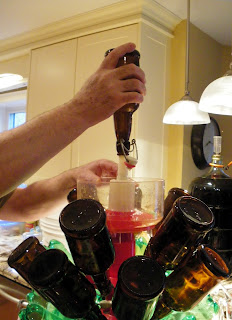Hello followers! Hope you're loving the snow!?!
So, here we are... The final blog for Homebrew Month. I really hope you have all enjoyed it, I know I certainly have! Cooking with beer has been quite interesting in itself. It's something I hadn't had much experience doing, but it's been a pleasure.
Last weekend the family got together for a 'Homebrew Feast' at my Aunt and Uncle's house in which we all ate the beer food that I have been featuring this month on my blog. Yum! Talk about a great excuse to get together! Besides my recipes, my Uncle Jeff made a beer chicken and my Mum made beer and Cheddar bread with onions and a beer cheesecake! Wow, now that cheesecake was decadent! These delicious beer laden dishes made our feast even more spectacular and I'd like to share the links to the recipes so you can enjoy them yourself! Oh yes, I have also attached my Mum's notes of how she changed the original recipes.
Beer Can Chicken
http://www.canadianliving.com/food/beer_can_chicken_with_italian_spices.php
Beer Bread with old Cheddar and Onions
Notes:
I used 1 cup of old cheddar per loaf.
I only kneaded the dough 5 mins each time.
I used a rolling pin to roll dough into rectangles (mine were 17 in by 8 in).
I did not make the cheese swirl rolls. I also slashed the tops of the loaves prior to baking with a sharp knife. I did cover my loaves with a light damp tea towel for the last rising. Plastic wrap sticks too much for the soft dough although I covered the bowls in the fridge rising with plastic wrap. Also note that you can leave the loaves to rise for an hour or two in your warm kitchen and they just get plumper.
Dark Beer Cheesecake
Notes:
3 x 250 gram packages or 750 grams full fat cream cheese= 1 1/2 lbs
4 x 500 ml containers of full fat sour cream = 2 lbs
For the cookies I used all butter shortbread (nut free) and made them into crumbs in food processor, mixed with 1/4 cup of melted butter.
I topped the cake with a fresh strawberry puree and halved fresh strawberries.
Okay followers, I won't take up anymore of your time. So, thank you so much for allowing me to make March quite the successful 'Homebrew Month'! I'm off to the Spring Cottage Life Show today to do cooking demonstrations with cookbook author Jane Rodmell. It's always a fun time! And make sure you all come back next week when I will kick off April with a delightful Springtime recipe! Bye for now!























































.JPG)